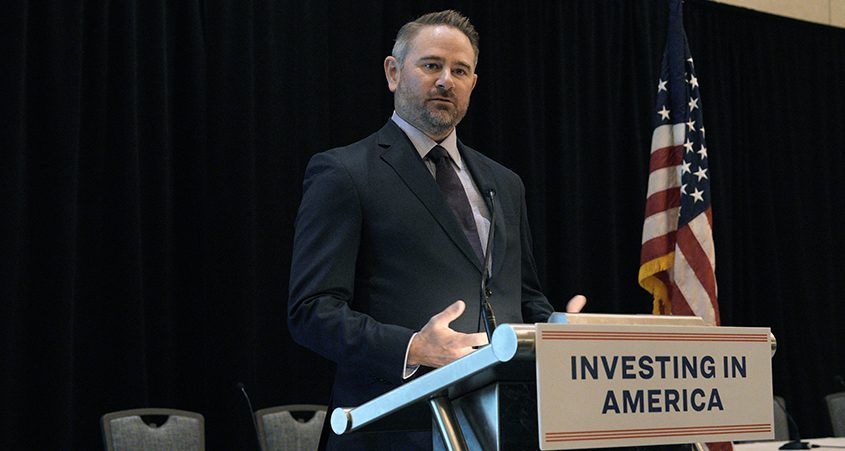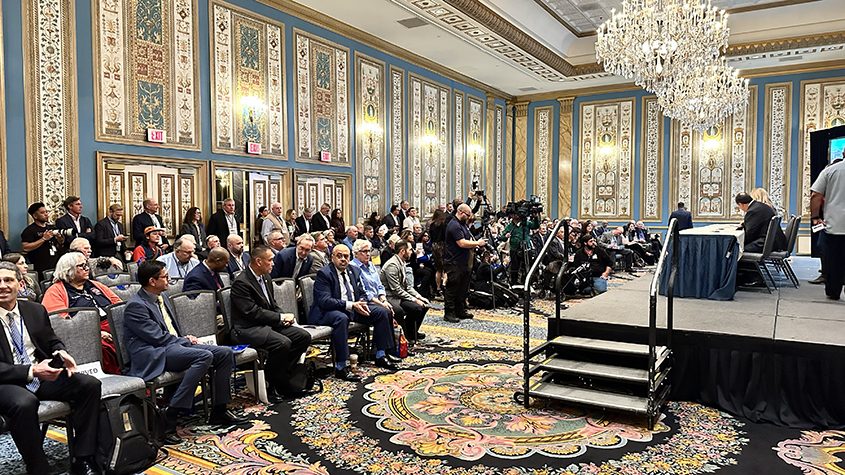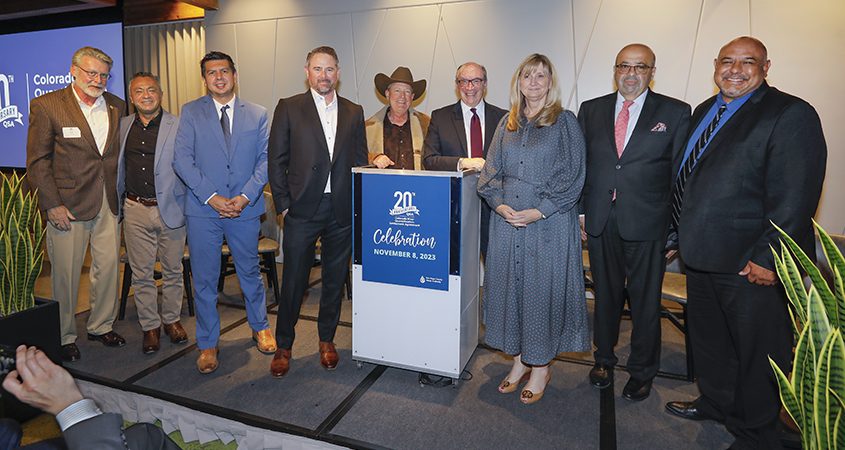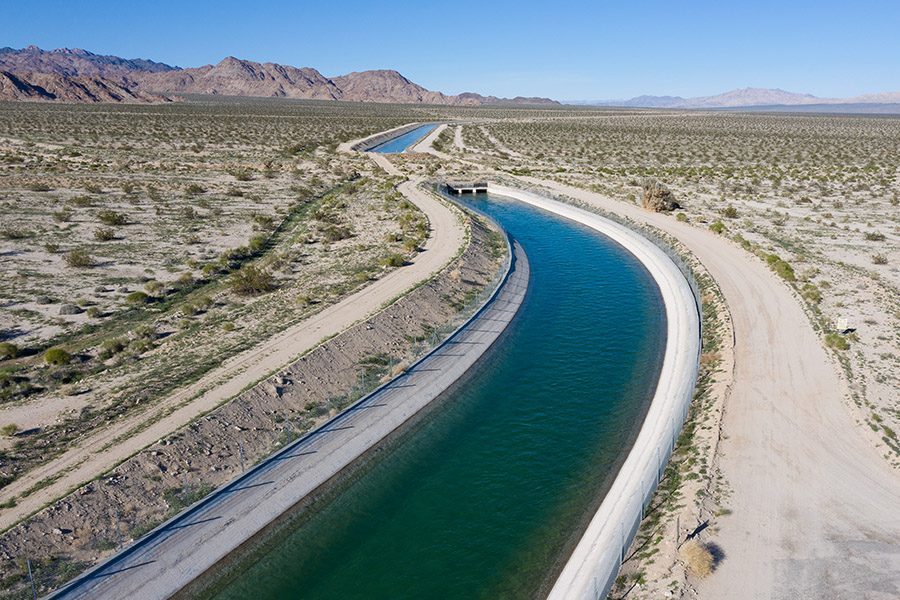US Drinking Water at Risk As Nitrogen Pollution in River Basins Increases
Drinking water in the United States is at risk, scientists have said, as nitrogen pollution seems to be increasing.
Drinking water in the United States is at risk, scientists have said, as nitrogen pollution seems to be increasing.
The latest forecast has arrived for the West’s largest reservoir — and, stop me if you’ve heard this one, it’s not great. Federal scientists are projecting that Lake Mead — created by Hoover Dam, which interrupts the Colorado River not far from Las Vegas — will fall close to its lowest level ever by the end of 2025, as the Las Vegas Review-Journal’s Alan Halaly reports.
The seven states that share the Colorado River’s water celebrated some conservation wins at their annual meeting here this week but quickly began sparring over who will bear the brunt of future pain that they agree a drying climate will dole out.
The San Diego County Water Authority today joined the Imperial Irrigation District, Metropolitan Water District of Southern California, Fort Yuma Quechan Indian Tribe, Palo Verde Irrigation District, Coachella Valley Water District, and the United States Bureau of Reclamation in signing a historic agreement to protect the Colorado River Basin. It is the first in a series of agreements to conserve 1.6 million acre-feet of water to remain in Lake Mead.
The landmark water agreements are a vital part of the Lower Basin Plan by Arizona, California, and Nevada to protect the Colorado River from extended drought — a plan identified this fall as Reclamation’s proposed action for near-term Colorado River operations. Funds to facilitate the deal are from the federal 2022 Inflation Reduction Act.
Water Authority Board Chair Mel Katz, General Manager Dan Denham, and Board member and vice chair of the Colorado River Board of California Jim Madaffer, were part of today’s signing ceremony in Las Vegas in conjunction with the Colorado River Water Users Association annual conference. The Water Authority’s piece of the multi-party pacts is expected to save the San Diego region $15 million to $20 million (depending on hydrological variables), which will help offset the impact of inflation and other factors pushing up water rates.

Water Authority General Manager Dan Denham speaks at the December 13 signing ceremony in Las Vegas, supporting a set of agreements to sustain the Colorado River and save money for San Diego County water ratepayers. Photo: San Diego County Water Authority
“This is a significant moment not just for today but for the long-term survival of the Colorado River,” said Denham. “All the critical pieces are here: willing partners, meaningful levels of conservation, federal funding, environmental benefits for the Salton Sea, and respect for the Law of the River.”
Today’s signed agreement ensures Lake Mead, the nation’s largest reservoir, can continue delivering water to millions of people and millions of acres of farmland, including in San Diego County, over the next three years. Additional agreements are anticipated to be signed in 2024 with the Bard Water District, the Coachella Valley Water District, and the Imperial Irrigation District.
“Less than a year ago, we faced the worst possible consequences of drought and interstate conflict. Today, California’s agricultural, urban, and tribal users are banding together through these agreements to protect the Colorado River as part of the Lower Basin Plan with the instrumental support of the Bureau of Reclamation. It’s an incredible turnaround,” said JB Hamby, chairman of the Colorado River Board of California and Colorado River Commissioner for California.

Witnesses to history await the Dec. 13 signing ceremony in Las Vegas, supporting a set of agreements to sustain the Colorado River and save money for San Diego County water ratepayers. Photo: San Diego County Water Authority
Today’s agreements build on the groundbreaking 2003 Quantification Settlement Agreement. The QSA achieves several goals by helping California meet conservation obligations under Reclamation’s Lower Colorado River Basin conservation program, supporting financial viability for participating agencies, and reducing the chances for more shortages. The river system has suffered drought-induced decline for more than 20 years.
“IID remains fully committed to working proactively with its partners for the long-term sustainability of the Colorado River and Lake Mead, the source of IID’s only water supply,” said Imperial Irrigation District General Manager Jamie Asbury. “We are equally committed to ensuring any impacts to the Salton Sea resulting from regional solutions with broader beneficiaries are appropriately addressed to protect our community.
“IID’s involvement, and particularly that of Imperial Valley growers who will be generating much of this water through voluntary on-farm conservation measures, exemplifies our collective commitment and support that will be paramount in the long-term success of the River.”
Metropolitan General Manager Adel Hagekhalil said: “Each one of these agreements is evidence of what we can achieve when we work together. This collaborative effort, including federal financial support and Metropolitan’s commitment to leave more than 400,000 acre-feet of water in Lake Mead this year, will help stabilize the reservoir while we negotiate longer-term solutions.
“There is much work ahead. Building lasting solutions will take even greater partnership and investment from us all.”
The Water Authority, MWD, and IID have been working together for several months on ways to capitalize on current water supplies. Due to a historically wet year, the State Water Project is delivering complete supplies to MWD, refilling reservoirs, and reducing demand for imported Colorado River water. The MWD Board of Directors approved the agreement in November, and the IID Board followed with its approval on December 1.
The Water Authority will leave 50,000 acre-feet of conserved QSA water in the Colorado River. This helps raise the level of Lake Mead, which has dropped in recent years. The volume is equivalent to the amount of water used in a year by approximately 150,000 single-family homes.
The Water Authority agreed to buy 50,000 acre-feet from MWD to meet current and future demands. The Water Authority’s cost savings result from the difference between the MWD rate and the rate for IID’s conserved water through the QSA. The Bureau of Reclamation will cover the cost of the Water Authority’s QSA supplies left in the river.
After steadily climbing all year, Lake Mead’s water levels have hit an unexpected milestone.
A new landmark water exchange agreement will increase water levels in Lake Mead, fight upward pressure on wholesale water rates, and create a new template for water management in the arid West.
The one-year agreement was announced on Friday, December 1 by the San Diego County Water Authority. The agreement is supported by the U.S. Bureau of Reclamation and executed in coordination with the Imperial Irrigation District (IID) and the Metropolitan Water District of Southern California (Metropolitan). Funds to facilitate the deal are from the federal 2022 Inflation Reduction Act.
The new agreement highlights ways water agencies can work together under existing laws and agreements to adapt to the changing climate.
“This is a great example of what happens when we collaborate and work together. Cooperation by all three water agencies and the Bureau of Reclamation produced a creative solution that helps sustain the Colorado River,” said Water Authority Chair Mel Katz. “Today’s announcement is an innovative win-win-win solution that helps us all meet the incredible challenges we face.”
The agreement builds on the groundbreaking 2003 Quantification Settlement Agreement (QSA). It achieves several goals by helping California meet conservation obligations under the Bureau of Reclamation’s Lower Colorado River Basin conservation program, supporting financial viability for participating agencies, and reducing the chances for more shortages. The Colorado River system has suffered drought-induced decline for more than 20 years.
The new arrangement is expected to save the Water Authority a projected $15 million to $20 million (depending on hydrological variables), which will help offset the impact of inflation and other factors on water rates.

Officials recognizing the Quantification Settlement Agreement 20th Anniversary (L to R): Jim Barrett, Coachella Valley Water District GM, Miguel Luna, Chair of the Legal and Claims Committee with the MWD Board, State Assemblyman David Alvarez (D-80), Water Authority GM Dan Denham, Colorado River Board of California Vice Chair and Water Authority board member Jim Madaffer, Water Authority Board Chair Mel Katz, Jamie Asbury, IID GM, MWD General Manager Adel Hagekhalil, IID GM Alex Cardenas. Photo: San Diego County Water Authority
The Water Authority, Metropolitan, and IID have been working together for several months on ways to capitalize on current water supplies. Due to a historically wet year, the State Water Project is delivering full supplies to Metropolian, refilling reservoirs and reducing demand for imported Colorado River water. The Metropolitan Board of Directors approved the agreement in November, and the IID Board followed with its approval on December 1.
“This partnership between Metropolitan, Imperial Irrigation District, the San Diego County Water Authority, and the Bureau of Reclamation is another example of how solutions developed collaboratively can benefit everyone,” said Adán Ortega, Jr., chair of the Metropolitan Board of Directors. “Our individual efforts to reduce our reliance on the Colorado River can be magnified by our growing and mutual interdependence leading to creative and lasting solutions, where the people we all serve win, as does the environment.”

In October 2003, the San Diego County Water Authority, Coachella Valley Water District, Imperial Irrigation District, Metropolitan Water District of Southern California, State of California, and U.S. Department of the Interior completed a historic set of agreements to conserve and transfer Colorado River water.
The Water Authority will leave 50,000 acre-feet of conserved QSA water in the Colorado River. This helps raise the level of Lake Mead, which has dropped in recent years. The volume is equivalent to the amount of water used in a year by approximately 150,000 single-family homes.
The Water Authority agreed to buy 50,000 acre-feet from Metropolitan to meet current and future demands. The Water Authority’s cost savings result from the difference between the Metropolitan rate and the rate for IID’s conserved water through the QSA. The Bureau of Reclamation will cover the cost of the Water Authority’s QSA supplies left in the river.
“This transfer is an example of how Southern California water agencies are leading with creative water management,” said Water Authority General Manager Dan Denham. “This agreement is based on decades of working together through the QSA, and it makes good on our collective commitment to the river. While this is a one-year arrangement, it will open the door for additional talks between partnering agencies in 2024.”
The Biden Administration will pay the Imperial Irrigation District an estimated $77.6 million for conserving 100,000 acre-feet of water in the Colorado River this year, setting the stage for more than half a billion dollars in federal funds to be paid to the agency, the river’s largest user, to conserve far more through 2026.
As part of the historic Lower Basin Plan between Arizona, California and Nevada to conserve 3 million acre-feet of water by 2026 to protect the Colorado River system from extended drought, the Imperial Irrigation District Board of Directors on Friday, Dec. 1 unanimously approved the 2023 System Conservation Implementation Agreement with the U.S. Bureau of Reclamation.
In a pivotal move addressing California’s water conservation goals and reinforcing partnerships in the face of the ongoing Colorado River drought, the Metropolitan Water District is seeking authorization for its General Manager to establish agreements with the Coachella Valley Water District, Imperial Irrigation District, and San Diego County Water Authority. These agreements aim to facilitate the addition of water to Lake Mead under the U.S. Bureau of Reclamation’s Lower Colorado River Basin System Conservation and Efficiency Program for the year 2023.
A month ago, predictions for Lake Mead’s future were reassuring. Now, the federal government is forecasting the lake will drop to a new low in less than two years.
A “most probable” report released Wednesday by the U.S. Bureau of Reclamation predicts the lake will be down to 1,040.77 feet in September 2025. That’s nearly a foot lower than Lake Mead was on July 27, 2022 — and the lowest the lake has been since it was filled in the 1930s.
